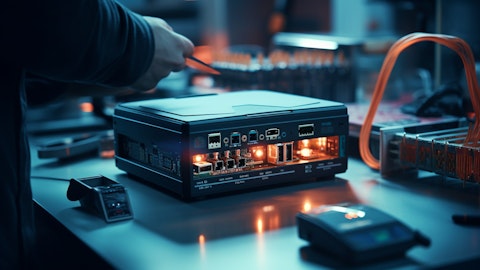Ron Konezny: If you look historically, I’d say that $40 million to $50 million range is probably where we’d be on a more normalized basis. The difference between that and our net inventory position is mainly components. So what we’re seeing those components be consumed and winding down and that’ll happen over the next several quarters. So over time, I think you’ll see us get out of that, let’s say, $40 million to 50 million range would be saved in more normal times.
Josh Nichols: Great. And then just as a follow-up question. Good to see that there’s probably some healthy cash flow generation from those working capital levers over the coming quarters. But I think previously when you talked about a little softness, you were speaking specifically that you saw on some Console Servers. It appears that was a little bit of a headwind in this quarter. I’m just curious any update on that, specifically for the demand is that — what’s causing that? And I know you said, it’s a little bit broad based, but I’m curious where we stand on terms of the Console Server side.
Ron Konezny: Yes. Josh, just to, kind of rewind the tape a little bit. As we entered FY 2024, we clearly signaled that the first half was going to be in our best estimate not as strong as the second half than it was maybe driven by some delays on the strategic side, so obviously that has played out as we expected. We are seeing some of our strategics, data center now starting to come back as we enter the second half, but I’d say it’s much more deliberate pace at which they’re coming back. So, what we are seeing, which is positive.
Josh Nichols: Thanks. I’ll hop back in the queue.
Operator: One moment for our next question. And our next question comes from Scott Searle with ROTH MKM.
Scott Searle: Hey. Good morning. Thanks for taking the questions. Hey Ron, just to clarify in terms of some of the demand outlook. It sounds like customers are certainly turning a bit more cautious, but is inventory — excess channel inventory playing at all into that current buying pattern? And then, I had a follow-up on a couple of the earlier questions on Opengear. It sounds like things are starting to move in the right direction. I think last quarter though you indicated that there were some larger customers that were expected to return. Have they returned or are they still kind of kicking out your decision making process?
Ron Konezny: Hey. Good morning, Scott. Yes, on the channel inventory side, it’s higher than I would say normal times. It’s exclusively driven by a few customers with allocated inventory. So yes, if they didn’t have as much inventory that probably would help on the sales side, but I want to emphasize a few select customers, it’s not broad-based. And in terms of the Console Server side, yes, we had indicated the first half of our fiscal year that we’ve got to be slow on that data center side, which is one of the reasons we thought that the first half may not be as strong as the second half. We are starting to see that return here in this current quarter. It’s more a month into it but we are seeing seem some buying time. They are being very deliberate, not getting a larger PO for the quarter for the next six months, and it’s more much more granular in terms of how they’re coming back.
Scott Searle: Got you. So Ron, just to clarify, so we should be thinking about open gear increasing sequentially into June and then into the back half of the calendar year? And then maybe switching over to the teller gateway side, that’s been weak as well. Share shifts, particular verticals or any other color that you could provide in terms of what’s going on with the demand profile there?
Ron Konezny : Yes. So the — your assumption is correct on the open year console server business. On the router side, I think there’s a couple of in dynamics going on. I think industrial IP IoT is still a strong market. The carriers to turn their attention, as you probably know, to FWA, — there’s a little bit more energy that they have on FWA and replacing wired Internet connections with wireless interconnections. We think we’re in a good spot from a competitive side with some things going on with some of our major competitors in North America. We’re bringing to in with his experience — I think is going to be a real strong lift for us as well as we look to build on some of our competitive positioning.
Scott Searle: Great. And lastly, if I could, just from a high level, there’s certainly a focus on ARR growing that from $100 million to $200 million over the next several years. But when I think about the product or hardware based side of the equation, a lot of transition is ongoing. What gets us back into growth mode? And what does that growth mode look like as we’re looking to fiscal 2025? Thanks.
Ron Konezny : Yes. The business is ARR has been a real bright spot for us. We’re up double digits year-over-year, again, this current quarter, and we expect ARR to continue to grow. And while Prime Services is going to be a big contributor to that, quite frankly, landing these enterprise deals kind of the solutions side of our business is going to have as much if not more impact. So we’re really encouraged by solutions and SmartSens, in particular, starting to contribute to the ARR growth. We do expect that we’ll continue to see some success there and help fulfill the ARR moving forward.




